Related Research Articles

The Challenger Deep is the deepest known point of the seabed of Earth, located in the western Pacific Ocean at the southern end of the Mariana Trench, in the ocean territory of the Federated States of Micronesia. According to the GEBCO Gazetteer of Undersea Feature Names the depression's depth is 10,920 ± 10 m (35,827 ± 33 ft) at 11°22.4′N142°35.5′E, although its exact geodetic location remains inconclusive and its depth has been measured at 10,902–10,929 m (35,768–35,856 ft) by deep-diving submersibles, remotely operated underwater vehicles, benthic landers, and sonar bathymetry. The differences in depth estimates and their geodetic positions are scientifically explainable by the difficulty of researching such deep locations.

The Mariana Trench is an oceanic trench located in the western Pacific Ocean, about 200 kilometres (124 mi) east of the Mariana Islands; it is the deepest oceanic trench on Earth. It is crescent-shaped and measures about 2,550 km (1,580 mi) in length and 69 km (43 mi) in width. The maximum known depth is 10,984 ± 25 metres at the southern end of a small slot-shaped valley in its floor known as the Challenger Deep. The deepest point of the trench is more than 2 km (1.2 mi) farther from sea level than the peak of Mount Everest.

Wreck diving is recreational diving where the wreckage of ships, aircraft and other artificial structures are explored. The term is used mainly by recreational and technical divers. Professional divers, when diving on a shipwreck, generally refer to the specific task, such as salvage work, accident investigation or archaeological survey. Although most wreck dive sites are at shipwrecks, there is an increasing trend to scuttle retired ships to create artificial reef sites. Diving to crashed aircraft can also be considered wreck diving. The recreation of wreck diving makes no distinction as to how the vessel ended up on the bottom.

A diving support vessel is a ship that is used as a floating base for professional diving projects. Basic requirements are the ability to keep station accurately and reliably throughout a diving operation, often in close proximity to drilling or production platforms, for positioning to degrade slowly enough in deteriorating conditions to recover divers without excessive risk, and to carry the necessary support equipment for the mode of diving to be used.

A deep-submergence vehicle (DSV) is a deep-diving crewed submersible that is self-propelled. Several navies operate vehicles that can be accurately described as DSVs. DSVs are commonly divided into two types: research DSVs, which are used for exploration and surveying, and DSRVs, which are intended to be used for rescuing the crew of a sunken navy submarine, clandestine (espionage) missions, or both. DSRVs are equipped with docking chambers to allow personnel ingress and egress via a manhole.
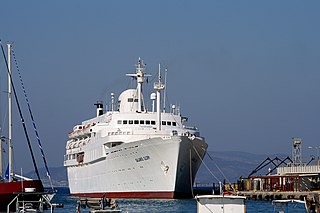
CS Salamis Glory was a cruise ship registered in Limassol, Cyprus. She cruised the Eastern Mediterranean Sea visiting countries such as Syria, Lebanon, Israel, Greece and Egypt out of Limassol. Entering service in 1962 for a Brazilian shipping company as Anna Nery, the cruise ship was involved in two collisions off Haifa, Israel during its career, one in 1963, 25 km off of Rio de Janeiro with a tanker, and again in 2007. The vessel was sold for scrap in 2009 and broken up.
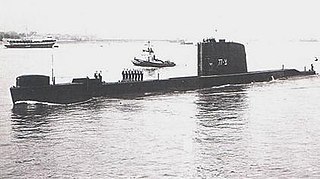
INS Dakar was a diesel–electric submarine in the Israeli Navy. The vessel, a modified World War II British T-class submarine, had previously been HMS Totem of the Royal Navy. She was purchased by Israel from the Government of the United Kingdom in 1965 as part of a three T-class submarine deal.

Marine salvage is the process of recovering a ship and its cargo after a shipwreck or other maritime casualty. Salvage may encompass towing, lifting a vessel, or effecting repairs to a ship. Protecting the coastal environment from oil spillages or other contaminants from a modern ship can also be a motivator, as oil, cargo, and other pollutants can easily leak from a wreck.

USS Muliphen (AKA-61/LKA-61) was an Andromeda-class attack cargo ship in service with the United States Navy from 1944 to 1970. She was sunk as an artificial reef in 1989.
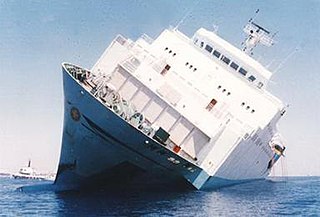
MS Zenobia was a Swedish-built Challenger-class RO-RO ferry launched in 1979 that capsized and sank in the Mediterranean Sea, close to Larnaca, Cyprus, in June 1980. She now rests on her port side in approximately 42 meters (138 ft) of water and was named by The Times, and many others, as one of the top ten wreck diving sites in the world.

Salvage diving is the diving work associated with the recovery of all or part of ships, their cargoes, aircraft, and other vehicles and structures which have sunk or fallen into water. In the case of ships it may also refer to repair work done to make an abandoned or distressed but still floating vessel more suitable for towing or propulsion under its own power. The recreational/technical activity known as wreck diving is generally not considered salvage work, though some recovery of artifacts may be done by recreational divers.
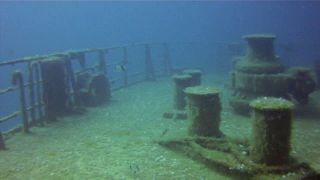
Um El Faroud was a 5,390 DWT Libyan-owned single screw motor tanker. Following a gas explosion during maintenance work on 3 February 1995, she was scuttled off the coast of Malta as an artificial reef and diving attraction.

Project Nekton was the codename for a series of very shallow test dives and also deep-submergence operations in the Pacific Ocean near Guam that ended with the United States Navy-owned research bathyscaphe Trieste entering the Challenger Deep, the deepest surveyed point in the world's oceans.

The Cheonghaejin class is a submarine rescue ship class of the Republic of Korea Navy. Only one ship has been built in the class, ROKS Cheonghaejin, in 1995. Its operations include rescuing trapped sailors in submarines, naval operation support for submarines, underwater research and mapping support, and recovery of sunk vessels. It is equipped with a deep submergence rescue vehicle (DSRV) that operates up to 500 metres (1,600 ft), and a rescue chamber that holds up to nine people.

Kommuna is a submarine salvage ship in service with the Russian Navy's Black Sea Fleet and the world's oldest active duty naval vessel. A double-hulled catamaran, she was laid down at the Putilov Factory in St. Petersburg in November 1912 as Volkhov. The ship was launched the following year, and commissioned on 14 July 1915. She was renamed Kommuna on 31 December 1922. Kommuna has served in the Russian Imperial, Soviet, and Russian Federation navies through the Russian Revolution and two World Wars.
Lady Thetis was a Cypriot passenger ship sunk for use as a recreational dive site in the Mediterranean Sea off Limassol, Cyprus.
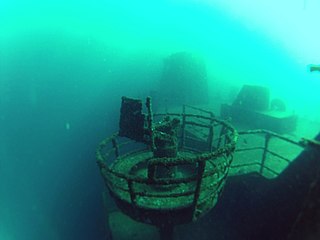
Al Munassir was an amphibious warfare vessel operated by the Royal Navy of Oman. It was purchased to enable the kingdom to respond to threats to the strategically important Musandam Governorate. The vessel was launched in 1978 and, after decommissioning, was sunk as an artificial reef in 2003. It is now a popular diving site.
MV Liberty was a Russian cargo ship which was turned into an artificial reef south of Cyprus in 2009. The ship had a gross tonnage of 225 GT, a length of 37 metres (121 ft), and a beam of 7 metres (23 ft).

MT or MVHephaestus was a bunkering oil tanker which ran aground off Qawra, Malta on 10 February 2018 and was subsequently scuttled as a dive site off Xatt l-Aħmar, Gozo on 29 August 2022.
References
- ↑ "Artificial reef heralds 'new era' for Cyprus diving". Archived from the original on 2015-04-02. Retrieved 2015-03-05.